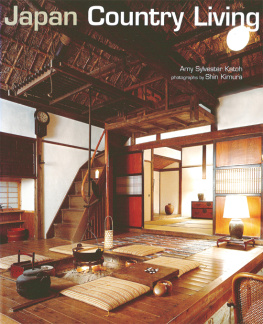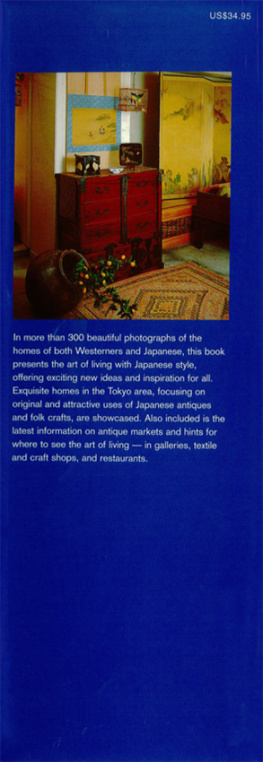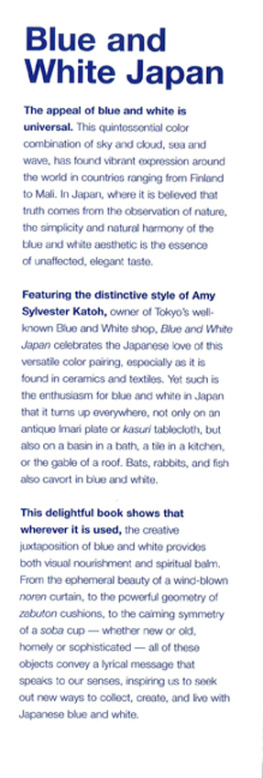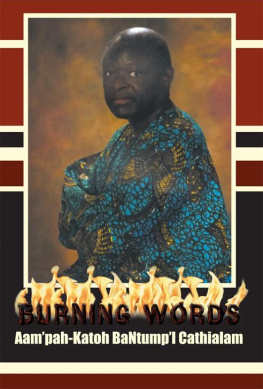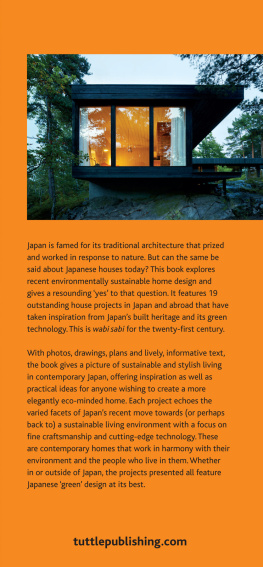Amy Sylvester Katoh - Japan Country Living
Here you can read online Amy Sylvester Katoh - Japan Country Living full text of the book (entire story) in english for free. Download pdf and epub, get meaning, cover and reviews about this ebook. publisher: Tuttle Publishing, genre: Detective and thriller. Description of the work, (preface) as well as reviews are available. Best literature library LitArk.com created for fans of good reading and offers a wide selection of genres:
Romance novel
Science fiction
Adventure
Detective
Science
History
Home and family
Prose
Art
Politics
Computer
Non-fiction
Religion
Business
Children
Humor
Choose a favorite category and find really read worthwhile books. Enjoy immersion in the world of imagination, feel the emotions of the characters or learn something new for yourself, make an fascinating discovery.
- Book:Japan Country Living
- Author:
- Publisher:Tuttle Publishing
- Genre:
- Rating:5 / 5
- Favourites:Add to favourites
- Your mark:
- 100
- 1
- 2
- 3
- 4
- 5
Japan Country Living: summary, description and annotation
We offer to read an annotation, description, summary or preface (depends on what the author of the book "Japan Country Living" wrote himself). If you haven't found the necessary information about the book — write in the comments, we will try to find it.
Japan Country Living — read online for free the complete book (whole text) full work
Below is the text of the book, divided by pages. System saving the place of the last page read, allows you to conveniently read the book "Japan Country Living" online for free, without having to search again every time where you left off. Put a bookmark, and you can go to the page where you finished reading at any time.
Font size:
Interval:
Bookmark:
ACKNOWLEDGEMENTS
For my family: to Yuichi, who first started me on this journey, to Mia and Saya, Tai and Toshi, who are always beside me. And for Toshiko and Sueko, who light the way. This book would have been impossible without the kindness and cooperation of countless people. Heartfelt thanks to the Akagi family, Mr. and Mrs. Akiyama, J.C. Brown, Diane Durston, Koji Fujibayashi of Sanso Murata, Kozo Fujita, Hiroko Izumi Fukuchi, Mr. and Mrs. Hagiwara, Mr. and Mrs. Hagiya, the Hiroji Hashimoto family, the Junji Hata family, IDr. Hide lshiguro, Senzo Ishikawa, Koji Kado, Kame no Ii, Yoshihiro Kamitani, the Hiromi Kanemaru family, the Kawasaki family, Yufuin, Kyushu, Marc Keane, Miwako Kimura, Ryoichi Kinoshita, Nanyen Kitamuro, Yuri Konomi, Hiroshi Kurata, Hiroshi Kutsukake, Mr. and Mrs. Richard Large, Kiyoko Machida,.Mitsu Minowa, Akio Mitsuno, Daisuke Miyashita, Mr. and Mrs: Miyatani, Sachi Molwi, Mr. and Mrs. Mori, Mr. and Mrs. Tadashi Morita, the Murata family, Makoto Nakano, Takashi Nakazato, the Nibe family, Takako Nishikawa, Margaret Price, Shinji Sakamoto and mother, Shinsaburo Shibuya, Nobuyoshi Shimomura, Mr. and Mrs. Hiroyuki Shipdo, Masanosuke Shirawaka, Barbara Stephan, Shinji Takagi, Yoichi Takimoto, Kenji Tsuehisawa, Mr. and Mrs. Uchida, Mr. and Mrs. Masao Umesao, Douglas and Kiyo Woodruff, Akemitsu Yamada, Mr. and Mrs. Yanagida, and Kazuko Yoshiura.

CONTENTS






Photos pp. 50-51 & 54 Akira Kita Photos pp. 14-15, 38-39, 145 Naoki Baba.
Published by Tuttle Publishing, an imprint of Periplus Editions (HK) Ltd.
Copyright 1993 by Charles E. Tuttle Co., Inc.
All rights reserved
LCC Card No. 93-60522
ISBN: 978-1-4629-0649-9 (ebook)
First published, 1993
Printed in Singapore
Designed by Katharine Markulin Hama
Distributed by:
North America, Latin America & Europe
Tuttle Publishing
364 Innovation Drive, North Clarendon, VT 05759-9436.
Tel: (802) 713 8930; Fax: (802) 973 6993 Email; info@tuttlepublishing.com
www.tuttlepublishing.com
Japan
Tuttle Publishing
Yaekari Building, 3rd Floor, 5-4-12 Osaki, Shinagawa-ku, Tokyo 141-0032
Tel: (03) 5437 0171; Fax: (03) 5437 0755 Email: tuttle-sales@gol.com
Asia Pacific
Berkeley Books Pte Ltd
61 Tai Seng Avenue #02-12, Singapore 534167
Tel: (65) 6280 1330; Fax: (65) 6280 6290 Email: inquiries@periplus.com.sg
www.periplus.com
05 07 09 10 08 06
2 4 6 8 7 5 3
TUTTLE PUBLISHING is a registered trademark of Tuttle Publishing.


COUNTRY WAYS
LIVING IN THE COUNTRY
Over the years I have been invited into and have had the chance to see the interiors of those wonderful Japanese thatched houses, which have so much appeal viewed from the roadside, tucked up against mountains at the edge of a valley's rice fields. Such houses have a life and character of their own. They speak to you immediately upon entering.
One unforgettable house was on a road in the middle of the Noto Peninsula. My friends and I caught sight of a noble roof soaring above the road. We walked up the hill and found that the house was even more impressive than it had seemed from below. The architecture commanded our attention, a rare and precious token of the past. The lady of the house was just stepping out of the barn, a purple crocheted sweater over her apron, and when we asked if we could look around, she smiled with a mixture of embarrassment and surprise, saying that it was old and dirty and we wouldn't be interested. But secretly she seemed pleased at our interest in her family compound, where she had lived all her married life. She quickly darted inside and alerted her husband, who, when he appeared, was frailer and older than she and had simply put a thick jacket over his pajamas to greet us. Both happily showed us their house and outbuildings and told us some of its history. The main structure was built 350 years ago, a massive fortress against snow and cold, which once was considerable. Some parts had been added, other parts restored. Up until forty years ago, the roof was thatched, but when that proved to be too much to keep up, they converted to a tile roof. The open courtyard from where we viewed the house was fronted by the main building, clearly the living quarters. Persimmons drying on cords festooned one wall. Small, hot red peppers were drying, too, and onions from the garden. Tools of the years and ladders were hung against the storehouse.



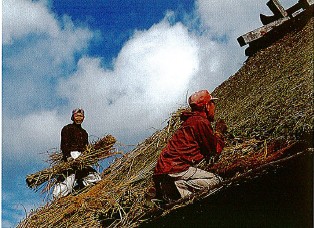
The elderly couple was somewhat taken aback by our unbridled rapture for their house. They had some ambivalence as to the value of preserving old houses. To some extent, it implies that one does not have enough money to rebuild something new and modern and convenient. Old and dirty are synonymous, and anyone who still lives in an old house is considered dirty and probably poor. Family reputation is involved. These two will continue to keep this house going as long as they can, but they are old. What will happen when they die? Who will carry on? Will the next generation be content to live in this relatively inconvenient way?
We, outsiders who have come from cities and from other countries, gasp at this massive and handsome piece of Japan's country heritage, and urge its owners to preserve and treasure the house and the lifestyle as they have the persimmons so painstakingly hung from the rafters.
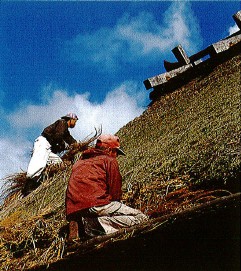
Another thrilling moment was on a trip through Miyama-cho, one of the remotest parts of Kyoto Prefecture, during the preparation of this book. We were honored by an unusual sight-a group of thatchers repairing the roof of a farmhouse. Like a woman lifting her skirts, the cover of the house had been raised and removed, and the supporting rafters were visible, spread at the base and tied together at the top. Smoky bamboo poles were being lashed on horizontally across the rafters, and thatch was being attached to them, stitched with a fat wooden needle and twisted straw twine. The beams and rafters were tied together with bindings of rice-straw rope. The village was made up of thatched houses, their distinctive straw bonnets dotting the land. I was amazed again at how utterly basic it all is-the structures, the materials, the landscape-and how incomparably beautiful.
Font size:
Interval:
Bookmark:
Similar books «Japan Country Living»
Look at similar books to Japan Country Living. We have selected literature similar in name and meaning in the hope of providing readers with more options to find new, interesting, not yet read works.
Discussion, reviews of the book Japan Country Living and just readers' own opinions. Leave your comments, write what you think about the work, its meaning or the main characters. Specify what exactly you liked and what you didn't like, and why you think so.

